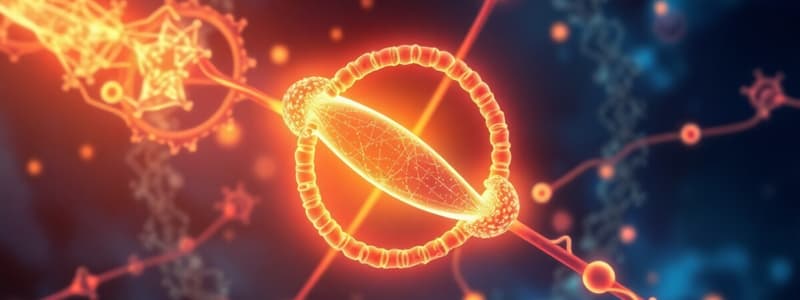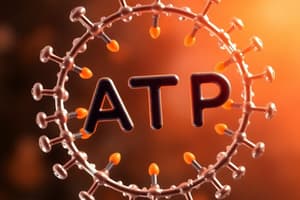Podcast
Questions and Answers
What is the primary role of chlorophyll b in photosynthesis?
What is the primary role of chlorophyll b in photosynthesis?
- It captures light energy and converts it into chemical energy.
- It is the main pigment responsible for red leaf coloration.
- It absorbs light energy and transfers it to chlorophyll a. (correct)
- It protects against excessive sunlight damage.
Which pigment is primarily responsible for the yellow color in fall leaves?
Which pigment is primarily responsible for the yellow color in fall leaves?
- Xanthophylls (correct)
- Anthocyanins
- Chlorophyll a
- Carotenoids
Which accessory pigment does not participate in photosynthesis?
Which accessory pigment does not participate in photosynthesis?
- Chlorophyll b
- Anthocyanins (correct)
- Carotenoids
- Xanthophylls
What distinguishes carotenoids from other accessory pigments?
What distinguishes carotenoids from other accessory pigments?
What is a function of xanthophylls in plants?
What is a function of xanthophylls in plants?
What is energy coupling in cellular processes?
What is energy coupling in cellular processes?
Which reaction is an example of an energetically favorable process in energy coupling?
Which reaction is an example of an energetically favorable process in energy coupling?
What is the role of chlorophyll in photosynthesis?
What is the role of chlorophyll in photosynthesis?
Why do leaves appear green to our eyes?
Why do leaves appear green to our eyes?
What are accessory pigments in plants?
What are accessory pigments in plants?
In the coupled reaction to form sucrose, which intermediate is formed from ATP?
In the coupled reaction to form sucrose, which intermediate is formed from ATP?
What happens to light wavelengths absorbed by chlorophyll?
What happens to light wavelengths absorbed by chlorophyll?
What characteristic determines the color of pigments in plants?
What characteristic determines the color of pigments in plants?
What is the primary purpose of ATP in living organisms?
What is the primary purpose of ATP in living organisms?
What happens to ATP when it undergoes hydrolysis?
What happens to ATP when it undergoes hydrolysis?
Which part of the ATP molecule is broken during the hydrolysis reaction?
Which part of the ATP molecule is broken during the hydrolysis reaction?
How does the energy released by ATP hydrolysis affect nearby molecules?
How does the energy released by ATP hydrolysis affect nearby molecules?
What is produced when ATP is broken down through hydrolysis?
What is produced when ATP is broken down through hydrolysis?
What characteristic of the three phosphate groups in ATP contributes to its instability?
What characteristic of the three phosphate groups in ATP contributes to its instability?
In the ATP-ADP energy cycle, what occurs after ATP has released energy?
In the ATP-ADP energy cycle, what occurs after ATP has released energy?
What energy-using cellular process does ATP directly support?
What energy-using cellular process does ATP directly support?
Flashcards
ATP
ATP
Adenosine triphosphate; organic molecule for short-term energy storage and transport.
Hydrolysis
Hydrolysis
Water-mediated breakdown of chemical bonds, releasing energy.
ADP
ADP
Adenosine diphosphate; a low-energy molecule formed from ATP when energy is released.
ATP-ADP Cycle
ATP-ADP Cycle
Signup and view all the flashcards
Energy Coupling
Energy Coupling
Signup and view all the flashcards
Plant Pigments
Plant Pigments
Signup and view all the flashcards
Cellular Processes
Cellular Processes
Signup and view all the flashcards
ATP Structure
ATP Structure
Signup and view all the flashcards
Chlorophyll b
Chlorophyll b
Signup and view all the flashcards
Carotenoids
Carotenoids
Signup and view all the flashcards
Anthocyanins
Anthocyanins
Signup and view all the flashcards
Xanthophylls
Xanthophylls
Signup and view all the flashcards
What do chlorophyll b, carotenoids, and xanthophylls have in common?
What do chlorophyll b, carotenoids, and xanthophylls have in common?
Signup and view all the flashcards
Exergonic Reaction
Exergonic Reaction
Signup and view all the flashcards
Endergonic Reaction
Endergonic Reaction
Signup and view all the flashcards
ATP Hydrolysis
ATP Hydrolysis
Signup and view all the flashcards
ATP Regeneration
ATP Regeneration
Signup and view all the flashcards
Accessory Pigments
Accessory Pigments
Signup and view all the flashcards
Photosynthesis
Photosynthesis
Signup and view all the flashcards
Study Notes
ATP Structure and Function
- ATP is an organic molecule used for short-term energy storage and transport in cells
- It consists of three parts: adenine (a nitrogenous base), ribose (a sugar), and three phosphate groups (triphosphate)
- The phosphate groups are negatively charged, making them unstable and prone to repulsion
- Hydrolysis (breaking down with water) of the phosphate bonds in ATP releases energy
- The breakdown results in adenosine diphosphate (ADP) and inorganic phosphate (Pi)
ATP-ADP Cycle
- ATP and ADP are like charged and uncharged forms of a rechargeable battery
- ATP (charged) has energy for cellular processes
- ADP (uncharged) needs recharging to be a power source
- ATP regeneration is the reverse of hydrolysis reaction
- Energy + ADP + Pi → ATP + H₂O
Energy Coupling
- Energy coupling links an exergonic reaction (releases energy, e.g., ATP hydrolysis) with an endergonic reaction (absorbs energy, e.g., ATP regeneration)
- This enables cells to perform necessary tasks
- Chemical reactions are either exergonic (release energy) or endergonic (absorb energy)
Examples of Energy Coupling
- Formation of sucrose (table sugar) from glucose and fructose is an example
- A phosphate group is transferred from ATP to glucose, forming glucose-P (energy-releasing)
- The glucose-P is converted into sucrose (energy is released as the reaction is spontaneous)
Plant Pigments
- Pigments absorb light from the sun
- Color variations in plants are due to different amounts and types of pigments
- Chlorophyll is a key pigment in leaves, absorbing light energy for photosynthesis
- It reflects green light, so plants appear green
- Other pigments (accessory pigments) absorb other wavelengths of light, extending the range of light used for photosynthesis
- These accessory pigments include chlorophyll b, carotenoids, and anthocyanins
- The pigments absorb different wavelengths of visible light (red, orange, yellow, green, blue, indigo, violet) to carry out their function
Location of Pigments in Plants
- Photosynthetic cells (mesophyll cells) contain specialized structures called chloroplasts
- Chloroplasts house chlorophyll and other pigments
- Pigments not involved in photosynthesis are stored in the vacuole
Studying That Suits You
Use AI to generate personalized quizzes and flashcards to suit your learning preferences.



